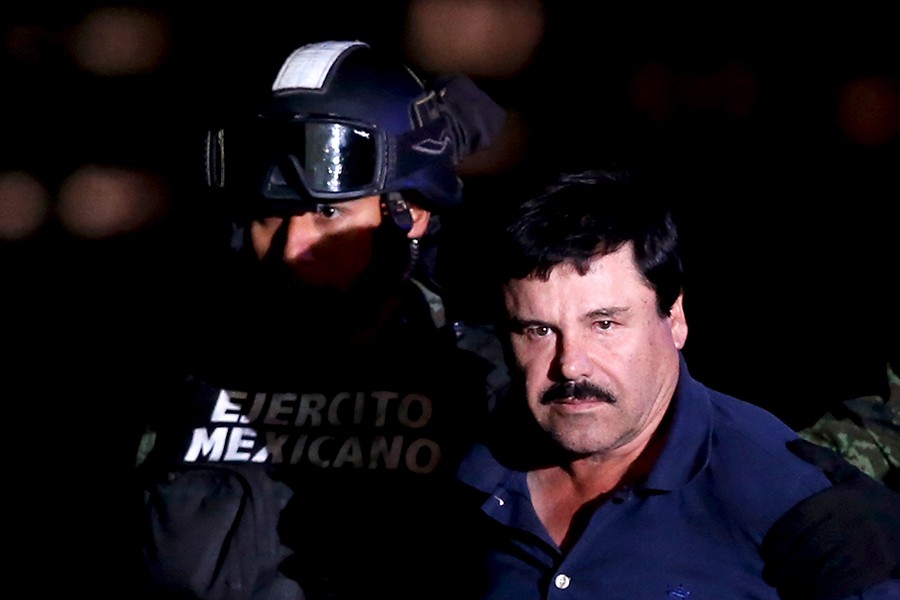The world’s most infamous cartel boss Joaquin “El Chapo” Guzman, who rose from poverty in rural Mexico to amass billions of dollars, was found guilty in a US court on Tuesday of smuggling tons of drugs to the United States over a violent, colorful, decades-long career.
Jurors in federal court in Brooklyn convicted Guzman, 61, head of the Sinaloa Cartel, on all 10 counts brought by US prosecutors.
Richard Donoghue, the US Attorney for the Eastern District of New York, said he expected Guzman to receive life without parole when sentenced on June 25. “It is a sentence from which there is no escape and no return,” Donoghue told reporters.
Guzman, one of the major figures in Mexican drug wars that have roiled the country since 2006, become almost legendary for escaping from Mexican high-security jails twice and avoiding massive manhunts. He cultivated a Robin Hood image among the poor in his home state of Sinaloa.
Guzman sat and showed no emotion while the verdict was read. Once the jury left the room, he and his wife Emma Coronel, put their hands to their hearts and gave each other the thumbs up sign. His wife shed tears.
Guzman, whose nickname means “Shorty,” was extradited to the United States for trial in 2017 after he was arrested in Mexico the year before.
Though other high-ranking cartel figures had been extradited previously, Guzman was the first to go to trial instead of pleading guilty.
The 11-week trial, with testimony from more than 50 witnesses, offered an unprecedented look at the inner workings of the Sinaloa Cartel, named for the state in northwestern Mexico where Guzman was born in a poor mountain village.
The US government said Guzman trafficked tons of cocaine, heroin, marijuana, and methamphetamine into the United States over more than two decades, consolidating his power in Mexico through murders and wars with rival cartels.
Small in stature, Guzman’s smuggling exploits, the violence he used and the sheer size of his illicit business made Guzman the world’s most notorious drug baron since Colombia’s Pablo Escobar, who was shot dead by police in 1993.
Guzman’s lawyers say he was set up as a “fall guy” by Ismael “El Mayo” Zambada, a powerful drug lord from Sinaloa who remains at large.
Jeffrey Lichtman, a lawyer for Guzman, told reporters after the verdict that the defence faced an uphill fight, given the amount of evidence the government presented, and the widespread perception that Guzman was already guilty.
“This was a case that was literally an avalanche, avalanche of evidence,” Lichtman said. “Of course we’re going to appeal.”
Drug Wars
Mexican President Andres Manuel Lopez Obrador was elected last year after promising a change to the deadly military-led war against drug gangs, suggesting a negotiated peace and amnesty for non-violent drug dealers, traffickers, and farmers.
The most detailed evidence against Guzman came from more than a dozen former associates who struck deals to cooperate with US prosecutors.
They told jurors how the Sinaloa Cartel gained power in the 1990s, eventually coming to control almost the entire Pacific coast of Mexico.
Guzman made a name for himself in the 1980s by building cross-border tunnels that allowed him to move cocaine from Mexico into the United States faster than anyone else.
The witnesses, who included some of Guzman’s top lieutenants, a communications engineer, and a onetime mistress, described how he built a sophisticated organisation reminiscent of a multinational corporation.
He sent drugs northward with fleets of planes and boats, and had detailed accounting ledgers, and an encrypted electronic communication system run through secret computer servers in Canada, the court heard.
Guzman’s attempt to take territory from a rival cartel was one of the main reasons for an explosion of drug violence in Mexico. The government has registered more than 250,000 homicides since it launched an aggressive war on cartels in 2006. A report by the US Congressional Research Service last year estimated 150,000 of those deaths were tied to organised crime.
A former bodyguard testified that he watched Guzman kill three rival drug cartel members, including one victim who he shot and then ordered to be buried even as he was still gasping for
Despite his ties to government officials, Guzman often lived on the run. Imprisoned in Mexico in 1993, he escaped in 2001 hidden in a laundry cart and spent the following years moving from one hideout to another in the mountains of Sinaloa, guarded by a private army.
He was seized again in 2014, but pulled off his best known escape the following year when he disappeared into a tunnel dug into his cell in a maximum security prison.
But the Mexican government says he blew his cover through a series of slip ups, including an attempt to make a movie about his life. He was finally recaptured in January 2016.
Despite Guzman’s downfall, the Sinaloa Cartel still has the biggest US distribution presence of Mexican cartels, followed by the fast-growing Jalisco New Generation Cartel, according to the US Drug Enforcement Administration.
Together, they are the biggest producers of drugs sold on US streets.


